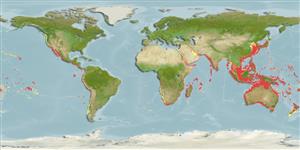Common names from other countries
Environment: milieu / climate zone / depth range / distribution range
Ecologia
Associadas(os) a recifes; intervalo de profundidade 0 - 222 m (Ref. 106682). Tropical
Southeast Atlantic and entire tropical Indo-Pacific from Red Sea and South Africa to the Hawaiian Islands.
Length at first maturity / Tamanho / Peso / Idade
Maturity: Lm ? range ? - ? cm Max length : 12.0 cm WD macho/indeterminado; (Ref. 800)
The five arms have blunt and tapered ends that curve slightly upwards. Both oral and aboral sides are flattened, with the aboral disc being slightly convex. Body color varies from greenish-blue, to brownish-gray and dark reddish-brown. This species is characterized by its distinctive laterally projecting rows of spines on the supero-marginal plate.
Life cycle and mating behavior
Maturidade | Reprodução | Desova | Ovos | Fecundidade | Larvas
Members of the class Asteroidea exhibit both asexual (regeneration and clonal) and sexual (gonochoric) means of reproduction. Life cycle: Embryos hatch into planktonic larvae and later metamorphose into pentamorous juveniles which develop into young sea stars with stubby arms.
Schoppe, S. 2000. (Ref. 800)
Categoria na Lista Vermelha da IUCN (Ref. 130435: Version 2024-1)
Categoria CITES (Ref. 108899)
Not Evaluated
Not Evaluated
Ameaça para o homem
Harmless
Utilização humana
| FishSource |
Ferramentas
Mais informação
Idade/TamanhoCrescimentoComprimento-pesoComprimento-comprimentoMorfologiaLarvasAbundância
Fontes da internet
Estimates based on models
Preferred temperature
(Ref.
115969): 15.3 - 29, mean 27.4 (based on 2738 cells).
Vulnerabilidade
Low vulnerability (10 of 100).
Categoria de preço
Unknown.
